Chaco Culture National Historical Park in New Mexico protects and preserve the massive buildings of the Ancestral Puebloan people.
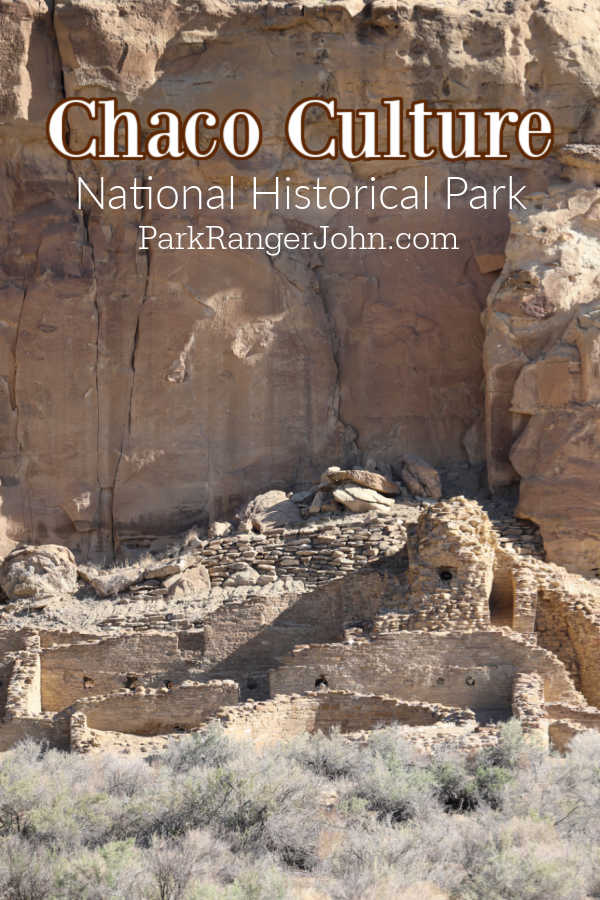
Chaco Culture National Historical Park
The first thing you need to know about visiting Chaco Culture NHP is getting to the park is a big part of the adventure.
You will want to be prepared for driving on dirt roads that are rutted, bumpy, and an adventure. I highly suggest making sure you check that your cooler is fully shut and anything you don't want bouncing around is secured.
I am going to fully admit that we didn't see a huge bump in the road coming and we hit it and our cooler caught air in the back of our SUV.
Once you reach the park the road turns to pavement and you can take a deep breath and enjoy the epic historical site.
One more warning...make sure to print directions or double-check the directions your GPS is sending you to.
There are road signs that will lead you to the park but you will want to make sure you have backup directions just in case
Make sure to bring plenty of food and water. There are no grocery stores near the park.
When you see a restroom make sure to use it! The visitor center has a nice clean bathroom.
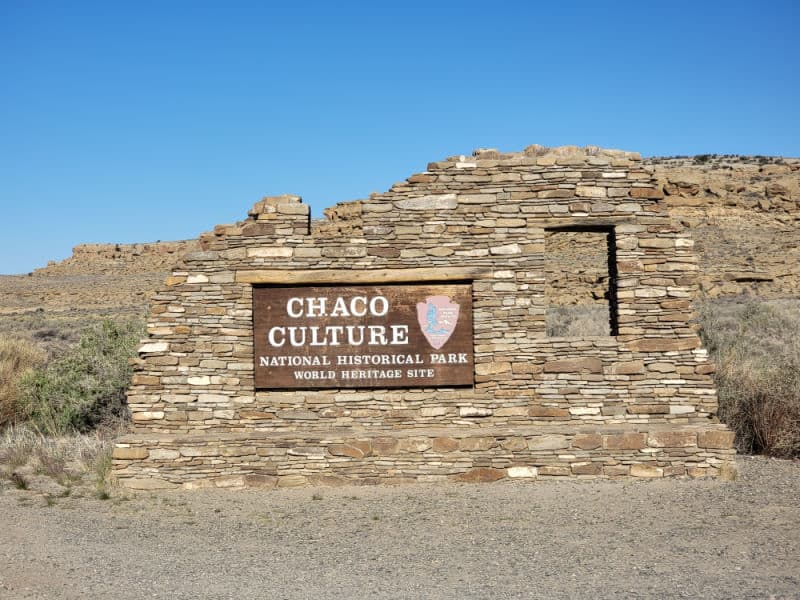
About Chaco Culture NHP
Chaco Culture National Historical Park is a sprawling park in northeast New Mexico. The park is home to many prehistoric, multistory buildings called great houses.
Among the great houses, Pueblo Bonito is the most famous and is the largest prehistoric structure in North America.
Chaco Culture NHP is one of 23 UNESCO World Heritage Sites in the United States.
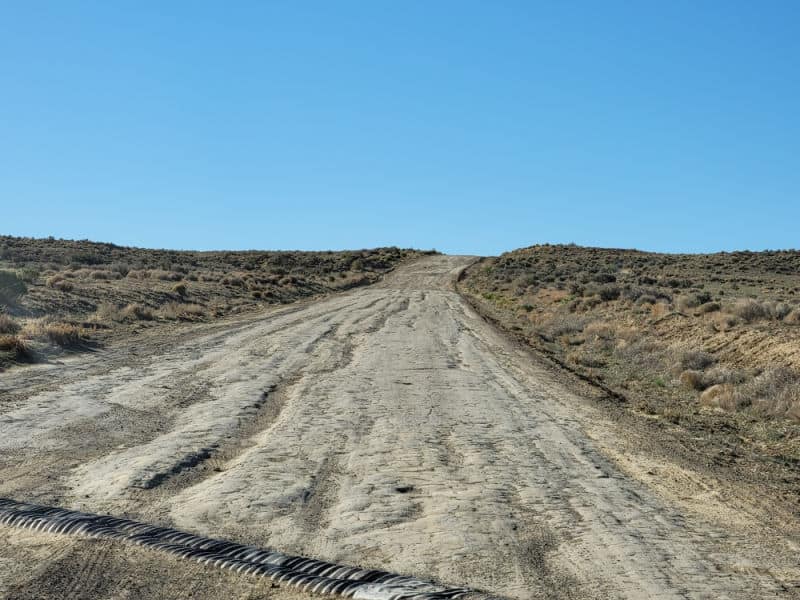
Is Chaco Culture NHP worth visiting?
Yes! I will say that a big part of the park is the adventure in reaching it. Once in the park it is amazing to see the ruins that are thousands of years old. It is hard to express the awe at seeing structures that continue to stand after thousands of years.
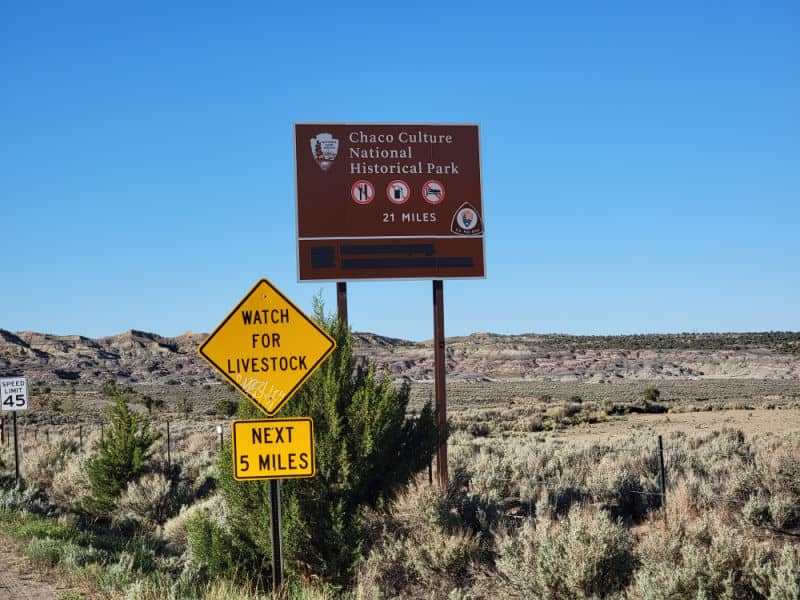
History of Chaco Culture NHP
Chaco Canyon is located within the San Juan Basin which is a unique feature within the Colorado Plateau.
The Colorado Plateau roughly lines up with the Four Corners region which includes portions of southwest Colorado, northwest New Mexico, northeast Arizona, and southeast Utah.
The San Juan basin shares features common to the Colorado Plateau. The beautiful, layered sandstone of this region was formed long, long ago with help from the Western Interior Seaway.
This sandy, shallow sea’s shifting shorelines covered and compressed layers of sand. Heat, time, and pressure created the striated layers clearly visible in the San Juan Basin’s walls.
Ancestral Puebloans used this sandstone to create their incredible great houses within Chaco Canyon. The San Juan River, fed by melting snow from the Rockies, cuts through the basin and was integral to the thriving culture created by the ancestral Puebloans.
History
Chaco culture blossomed for four hundred years from approximately 850-1250. The culture gave way to environmental pressures caused by drought and rapidly migrated out of the region in the early 1200s.
However, in those 400 years some of the most impressive structures in world history were created. The great houses remain mysterious as the ancestral Puebloans had no known writing system. Some great houses had hundreds of rooms and were up to five stories tall.
It is believed that the magnificent structures were not permanently occupied and may have primarily been a gathering place for economic, cultural, and religious events.
We do know that the structures within Chaco Canyon were important destinations within a trade network which spiderwebbed 1000s of miles across North and Central America. Recent archaeological work at Pueblo Bonito found traces of the cacao bean which was cultivated in Central America during the era of Chacoan culture.
Pueblo Bonita
Pueblo Bonito is the best preserved and best known great house. The aridity of the San Juan Basin has helped to preserve this incredible structure. Aerial views of the site do not do the scope and scale of the site justice.
The massive sandstone structure may have contained over 800 rooms and dozens of kivas. Kivas are circular depressions used for religious ceremonies by many Native American cultures in the southwest.
It is inferred from the presence of so many kivas of varying sizes in Pueblo Bonito that this great house served as a religious center.
Construction of Pueblo Bonito began in the mid 800s but declined in the early 1100s. Pueblo Bonito is laid out in a giant half-circle. The half-circle is again divided into roughly mirrored halves. Intentional, balanced design is obvious.
Something strange about the site is that despite its incredible size, it seems to have been permanently occupied by only a few families.
For a building that could have potentially housed 1000s, archaeologists have discovered no evidence that the great house was at capacity for any significant stretches.
Relative to Pueblo Bonito’s size, few graveyards or substantial trash deposits have been found. The ancestral Puebloans of Chaco Canyon remain mysterious.
After depopulation of the area due to drought in the early 1100s, it seems as though the area was sparsely populated for centuries. By the time Spanish arrived in the region in the 1600s, the Navajo people and culture were settled across the region.
The United States Encounters Chaco Canyon
Following the conclusion of the Mexican-American War (1846-1848) the United States took possession of the modern U.S. Southwest. Speculators and government survey teams undertook the grand project of mapping and analyzing the new lands.
The first American known to have documented the great houses and sifted through their artifacts is Lt. James Simpson. Official exploration was put on hold during the Civil War and early Reconstruction.
However, the excavation, documentation, and looting of Chaco Canyon began again in earnest in the late 1870s. This competition to both preserve and exploit the canyon continued until March 11, 1907.
Becoming a National Park
Chaco Canyon National Monument was established in early 1907. The federal government began monitoring the park and overseeing academic investigations of its mysteries.
During the 1920s thousands of artifacts were sent from Pueblo Bonito to the Smithsonian. Dramatically, in 1941 a giant boulder crumbled the cliff-facing wall of Pueblo Bonito destroying dozens of rooms.
Research of the ancestral Puebloan buildings within Chaco Canyon is still ongoing. Advancing technology reveals the expansive trade networks connected to ancient peoples of the San Juan Basin. Archeoastronomy revealed the sophisticated celestial alignments of buildings.
Beginning in the 1980s, National Park Services began collaborating with Native American groups whose ancestry is traced to the Puebloans. Oral histories from these cultures have brought better understanding of the history of the area.
Chaco Culture National Historical Park is one of the grandest and best preserved prehistoric sites within North America. You can walk ancient paths and tour millennium-old great houses.
The pristine environment is wonderful for exploring desert and scrubland flora and fauna. The night skies mark for ideal stargazing.
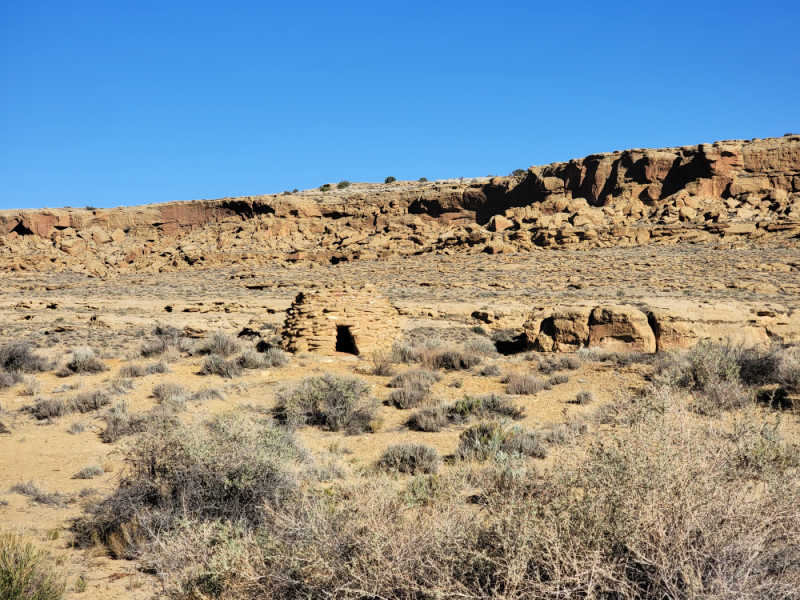
Things to know before your visit to Chaco Culture NHP
Entrance fee
Vehicle Entrance Fee - $25.00
Vehicle entrance is for all visitors who drive to the park in private vehicles and provides admittance for seven days.
Motorcycle Entrance Fee - $20.00
Motorcycle entrance allows one motorcycle to enter for seven days.
Individual Entrance Fee - $15.00
Allows a single individual traveling on foot, bicycle or as an individual in a non-commercial group to enter the park for seven days.
Learn more about National Park Passes for parks that have an entrance fee.
$80.00 - For the America the Beautiful/National Park Pass. The pass covers entrance fees to all US National Park Sites and over 2,000 Federal Recreation Fee Sites for an entire year and covers everyone in the car for per-vehicle sites and up to 4 adults for per-person sites.

Buy your pass at this link, and REI will donate 10% of pass proceeds to the National Forest Foundation, National Park Foundation, and the U.S. Endowment for Forestry & Communities.
National Park Free Entrance Days -Mark your calendars with the five free entrance days the National Park Service offers annually.
Time Zone
MST - Mountain Standard Time
Pets
Pets are allowed in the park in certain areas. They must be in a leash less than 6 feet in length.
Pets are allowed on the backcountry hiking trails (Pueblo Alto, Peñasco Blanco, South Mesa, and Wijiji trails).
Pets are not allowed within the archeological sites.
Cell Service
We had a tiny amount of service near the visitor center.
Park Hours
Hiking trails and archaeological sites are open daily from 7:00am to 9:00pm, with the entry gate to loop road closing 30 minutes prior to closing, which is at 8:30 pm.
The Visitor Center is open from 9:00 am-5:00 pm, November-April
The Visitor Center is open from 9:00 am-5:00 pm, May-October
The park and campground are closed on Thanksgiving, Christmas Day and New Year's Day.
Wi-Fi
We did not have Wi-Fi during our visit.
Insect Repellent
Insect repellent is always a great idea when outdoors, especially if you are around any body of water.
We use Permethrin Spray on our clothes before our park trips.
Water Bottle
Make sure to bring your own water bottle and plenty of water with you. Plastic water bottles are not sold in the park.
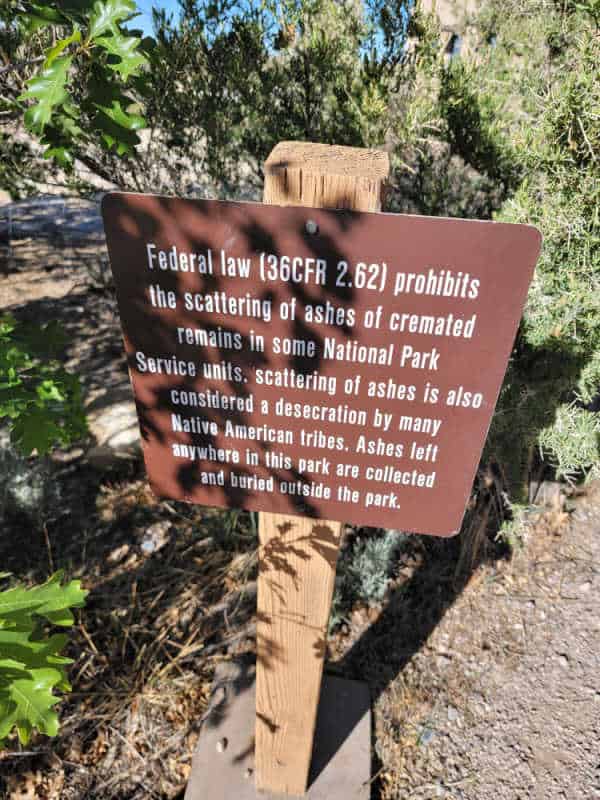
Parking
There is a nice size parking lot by the visitor center. Once you leave the visitor center there is smaller parking lots at the main ruins.
Food/Restaurants
There are no restaurants within the park.
The convenience store at the junction of Hwy 550 and County road 7900 is the last commercial establishment where you can obtain any supplies you may need.
Gas
There are no gas stations within the park. Make sure you have enough gas to make it to the park.
Drones
Drones are not allowed to be flown within the park.
National Park Passport Stamps
National Park Passport stamps can be found in the visitor center.
Make sure to bring your National Park Passport Book with you or we bring these circle stickers so we don't have to bring our entire passport book.
Chaco Culture NHP is part of the 2000 Passport Stamp Set.
Electric Vehicle Charging
The closest EV Charging stations are in Farmington, New Mexico.
Details about Chaco Culture National Historical Park
Size - 33,977 acres
Check out how the park compares to other National Parks by Size.
Date Established
March 11, 1907 the park was established by President Theodore Roosevelt
Visitation
In 2021, Chaco Culture NHP had 31,922 park visitors.
In 2020, Chaco Culture NHP had 8,231 park visitors.
In 2019, Chaco Culture NHP had 47,342 park visitors.
Learn more about the most visited and least visited National Parks in the US
Chaco Culture National Park Address
1808 CR 7950
Nageezi, NM 87037
Chaco Culture NHP Map
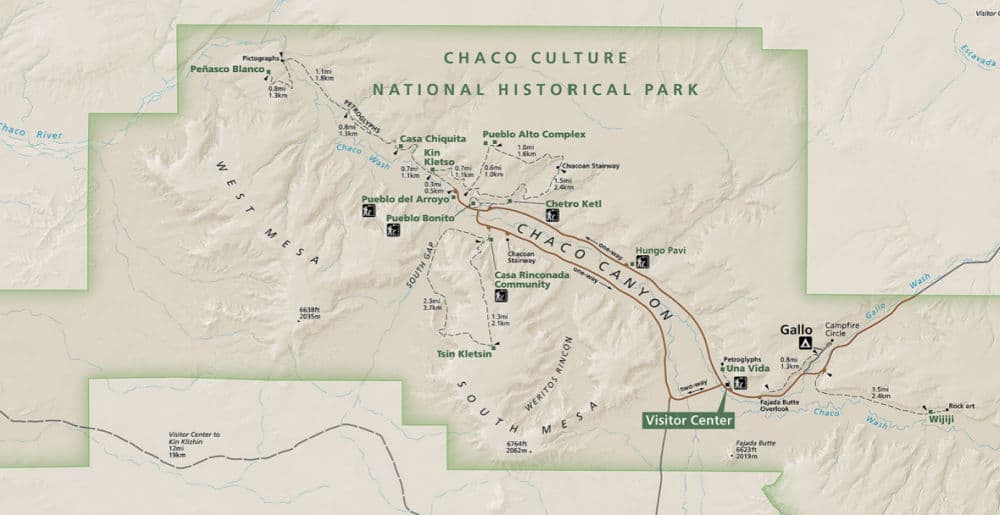
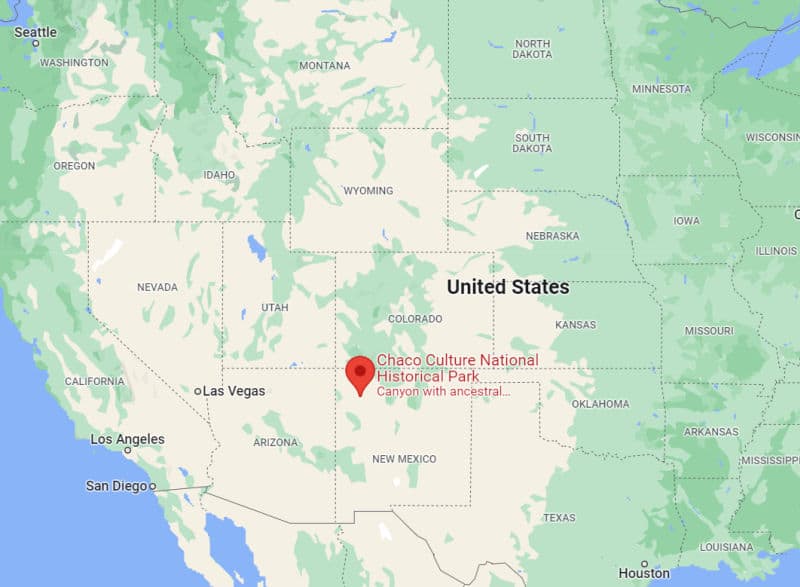
Where is Chaco Culture NHP?
Chaco Culture NHP is located in Northwestern New Mexico near Four Corners. The closest town is Farmington, New Mexico.
Estimated distance from major cities nearby
- Farmington, NM - 74 miles
- Gallup, NM - 94 miles
- Albuquerque, NM - 155 miles
- Sante Fe, NM - 179 miles
- Flagstaff, AZ - 276 miles
- Phoenix, AZ - 373 miles
- Amarillo, TX - 440 miles
- Colorado Springs, CO - 381 miles
- Durango, CO - 104 miles
Estimated Distance from nearby National Park
Petrified Forest National Park - 164 miles
Great Sand Dunes National Park - 248 miles
Black Canyon of the Gunnison National Park - 222 miles
Arches National Park - 260 miles
Grand Canyon National Park (South Rim) - 363 miles
Bryce Canyon National Park - 449 miles
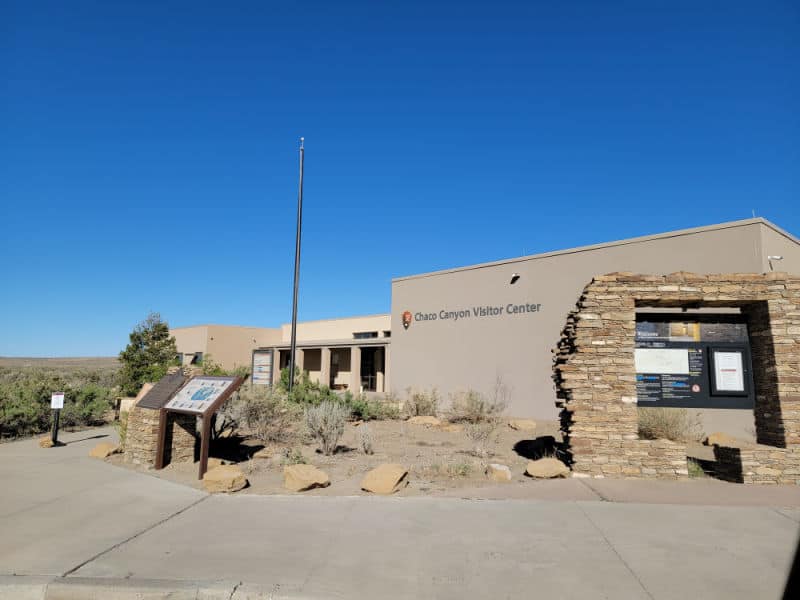
Where is the National Park Visitor Center?
The visitor center is 2.5 miles past the entrance gate.
Getting to National Park
The nearest airports are Farmington, NM, Gallup, NM, Durango, CO, and Albuquerque, NM.
There is no public transportation to the park.
Driving Directions
You will want to print the park's directions before heading out to the park. Your GPS may send you down an unsafe road.
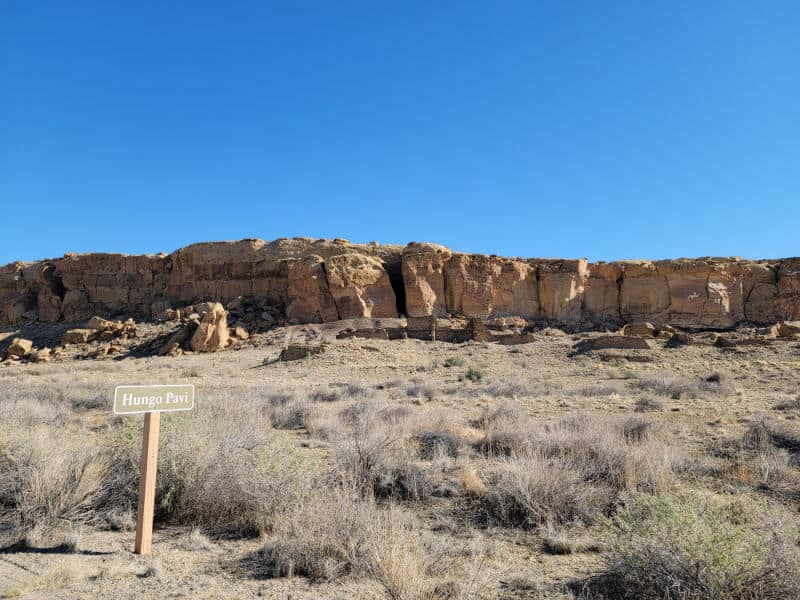
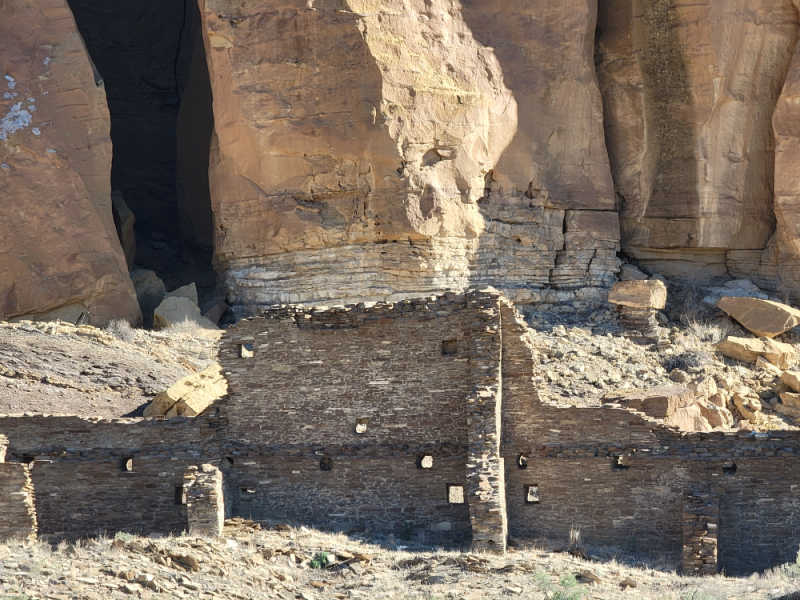
Best time to visit Chaco Culture National Historical Park.
Spring and Fall are great times to visit the park. During the summer it can be incredibly hot and thunderstorms are fairly common.
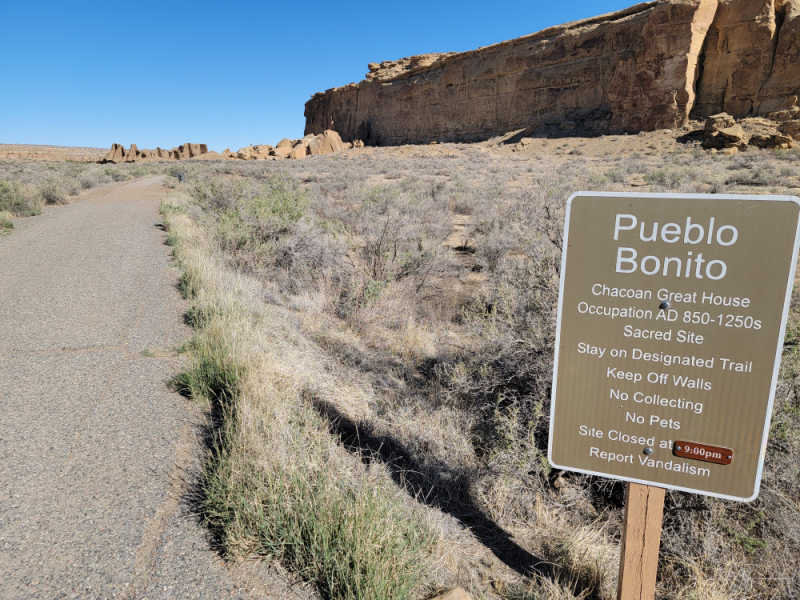
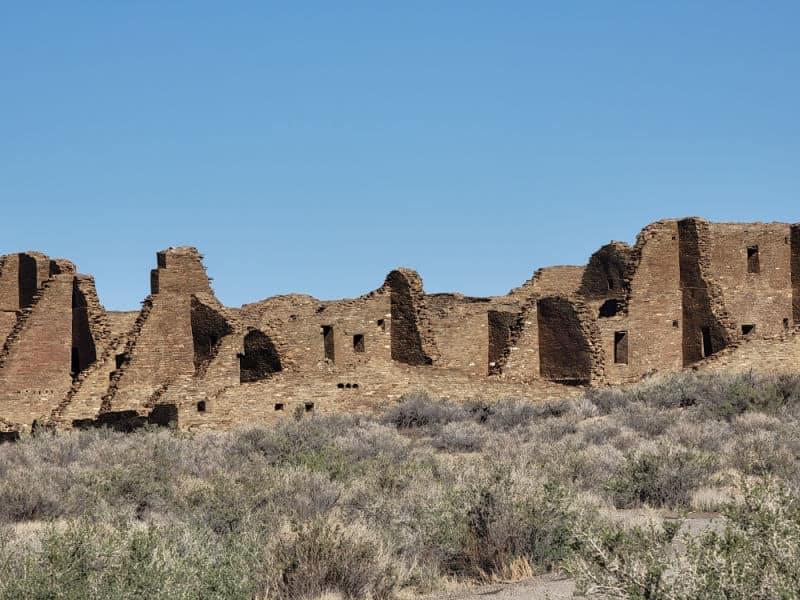
Chaco Culture National Historical Park Weather and Seasons
Chaco Culture NHP is located at 6,200 feet in elevation. The park experiences unpredictable and sometimes extreme weather.
During the summer temperatures are normally in the 80s to mid-90s with potential thunderstorms.
During the winter the temperatures drop below freezing most nights.
Spring and Fall bring moderate temperatures but unexpected storms can happen.
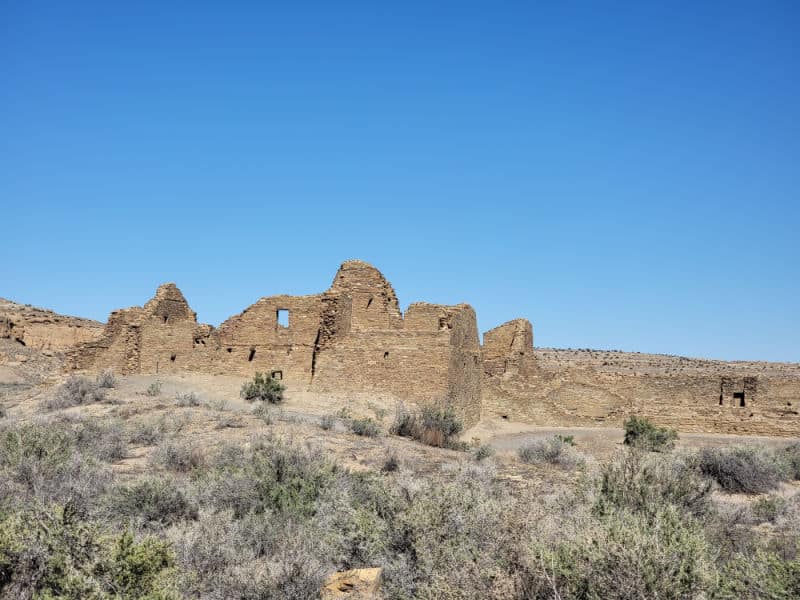
Best Things to do in Chaco Culture National Park
We suggest planning at least one day for visiting Chaco Culture NHP. It is an adventure getting to the park so you want to have time to enjoy it once you are there.
Visitor Center
The visitor center is a great place to start your visit to the park.
The hours of operation are 8:00 am-5:00 pm May through October and 8:00 am-4:00 pm November through April.
The visitor center is closed on Thanksgiving, Christmas, and New Year's Day.
From the visitor center, you can walk the 1-mile round trip trail to Una Vida to see a small partially excavated ruins site.
Junior Ranger Program
The Junior Ranger Program is a great opportunity for visitors of all ages to learn more about the park.
Canyon Loop Drive
The 9 mile Canyon Loop Drive is self-guided and takes you past the six major sites in the park including Una Vida, Hungo Pavi, Pueblo Bonito, Chetro Ketl, Pueblo del Arroyo, and Casa Rinconada.
The bookstore sells guides for Canyon Loop Drive.
Ranger programs
Rangers lead walks year-round to Pueblo Bonito. From April to October additional Park Ranger programs are offered.
International Dark Sky Park
Chaco Culture National Historical Park is an International Dark Sky Park! Over 99% of the park is a natural darkness zone with no permanent outdoor lighting.
Chaco Culture NHP was the 4th National Park Service site to receive the designation of a Dark Sky Park.
Night Sky programs are offered at times in the park.
Biking
Visitors can bike the 9 mile paved Canyon Loop Drive. There are bike racks at the visitor center and at the following Chacoan sites - Hungo Pavi, Pueblo Bonito and Cheto Ketl, Pueblo del Arroyo, and Casa Rinconada.
Wildlife
Wildlife in the park includes the Eastern Collared Lizard, Mexican Spadefoot Toad, Tiger Salamander, Western Rattlesnake, Sagebrush Lizard, Plateau Whiptail Lizard, and Night Snake.
There have been 131 bird species that have been documented in the park in the past 30 years.
Common birds include Turkey Vultures, Cooper's Hawks, Red Tail Hawk, American Kestrel, Great Horned Owl, Black-chinned hummingbirds, Broad-tailed hummingbirds, Ash-throated Flycatcher, Loggerhead Shrike, and Juniper Titmouse.
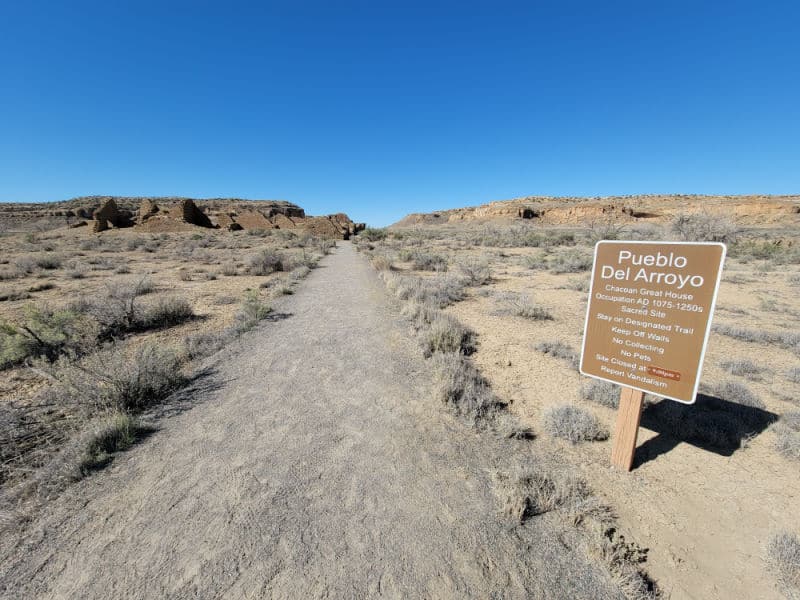
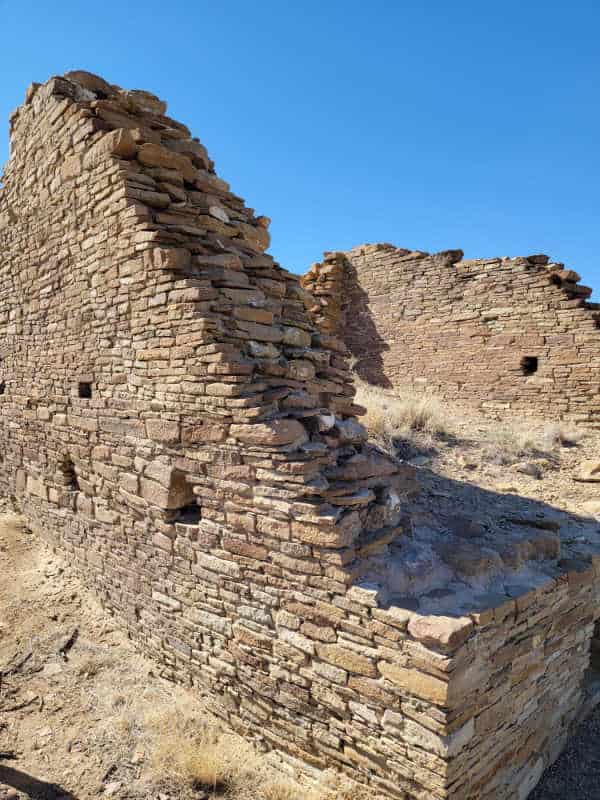
Hiking in Chaco Culture NHP
Always carry the 10 essentials for outdoor survival when exploring.
Una Vida & Petroglyphs
- Distance - 1-mile roundtrip
The 1 mile round trip trail begins in the Visitor Center Parking Lot. The trail includes seeing petroglyphs and Una Vida which is a Chacoan "great house". The multi-storied building has distinct masonry and a great kiva.
Today Una Vida is in a near-natural state of preservation.
Portions of the trail are rocky, steep, and slippery when wet. Make sure to take water with you.
In Spanish Una Vida means "one life"
Hungo Pavi
- Distance - Less than a ¼ mile
The trailhead for Hungo Pavi is located 2 miles from the visitor center along the 9-mile loop road.
Hungo Pavi is an unexcavated Chacoan great house containing 150 rooms, a great kiva, and an enclosed plaza.
Hungo Pavi's construction began in the A.D. 1000s when the Chacoan culture was flourishing. The hard sandstone was hand quarried from the top of the cliffs.
Water and mixed clay and sand were mixed to create mortar.
Chetro Ketl
- Distance - ½ mile roundtrip
The trailhead for Chetro Ketl is 4.5 miles from the visitor center on Canyon Loop Drive.
Chetro Ketl is the 2nd largest Chacoan great house in the park. It covers more than 3 acres and has a great kiva and elevated kivas.
The trail is gravel and climbs a few short but steep rises.
Pueblo Bonito
- Distance - .6 miles roundtrip
The trailhead for Pueblo Bonito is located 4.5 miles from the visitor center on Canyon Loop Drive.
The park designates Pueblo Bonito as the most important site in the entire park.
The trail is gravel and has a few short but steep rises to reach the Chacoan great house.
Pueblo Bonito is the great house that has been investigated the most. Puebloan people planned and constructed the site in stages between AD 850 and AD 1150.
This was the center of the Chacoan world.
In Spanish Pueblo Bonito means "pretty village"
Casa Rinconada
- Distance - .5 miles round trip
The trailhead for Casa Rinconada is located 6 miles from the visitor center on Canyon Loop Drive.
The trail is gravel and has a few steep rises.
Pueblo del Arroyo
- Distance - .25 miles roundtrip
The trailhead for Pueblo del Arroyo is located 5.5 miles from the visitor center on Canyon Loop Drive.
Pueblo del Arroyo was planned and constructed in two short stages from about AD 1025 to AD 1125.
Petroglyph Trail
- Distance - .5 miles
The Petroglyph Trail connects Pueblo Bonito and Chetro Ketl along the cliff face.
The park suggests bringing binoculars to get the best look at the high petroglyphs.
Backcountry Trails
There are four backcountry trails that go to remote Chacoan sites. The trails are open from 7 am until sunset.
Permits are required before heading out on a backcountry trail. The permits can be found at the visitor center or at each trailhead.
There is no overnight backcountry camping.
Pueblo Alto Trail
- Distance - Entire loop trail – 5.4 mi roundtrip
- Pueblo Alto - 3.2 mi roundtrip
- Pueblo Bonito Overlook – 2.0 mi roundtrip
Trailhead - Pueblo del Arroyo parking area
This trail leads to an overlook with views of Pueblo Bonito, Chetro Ketl, and Kin Klesto.
Peñasco Blanco Trail
- Distance - 7.4 miles roundtrip
- Petroglyph only trail - 3.5 miles roundtrip
- Supernova Pictograph Trail - 5.8 miles roundtrip
The Peñasco Blanco Trail includes the petroglyph trail and gives visitors the opportunity to view Pueblo and Navajo petroglyphs and historic inscriptions.
Make sure to pack lots of water and be prepared for the hot sun and sand.
South Mesa Trail
- Distance - 4.1-mile roundtrip entire loop trail
- Tsin Kletzin - 3.0 mile roundtrip
The trail leaves from Stop 10 on the Casa Rinconada trail and climbs to a high point on South Mesa. The trail continues to Tsin Kletzin.
The trail descends into South Gap and follows the Chacoan South Roads before re-entering the canyon near Casa Rinconada.
Wijiji Trail
- Distance - 3.0 miles round trip from the parking area
- 3.2 mile round trip from the Gallo Campground.
The trail leads to Wijiji which is a later-period Chacoan great house that was built around AD 1100.
This site appears to have been built at once rather than overtime. There is a .2 mile petroglyph spur trail.
Wijiji-This likely derives from the Navajo word Dewoozhii, meaning “greasewood.” Another nickname
is Kin Dootl’izhii meaning “turquoise house.”
How to beat the crowds in Chaco Culture NHP?
We only saw a couple of other cars during our entire visit.
Where to stay when visiting National Park
There are no National Park Lodges within the park.
Authentic Native American Hogan Experience - Stay in an authentic Navajo Hogan with amazing stargazing and views for miles at 8000' elevation for a desert "glamping" experience of a lifetime! Fully updated home (new kitchen, washer/dryer, full bath) decorated with custom Navajo textiles and all modern conveniences backs up to Navajo Reservation and is situated on a Christian Mission campus. With a king size bed for two adults and a comfortable full sized futon for the kids, this home sleeps three adults or two adults and two children comfortably.
Farmington Hotels include:
Fairfield Inn & Suites by Marriott Farmington - We stayed at this hotel and it worked out great. Take advantage of free breakfast, a grocery/convenience store, and dry cleaning/laundry services at Fairfield Inn & Suites by Marriott Farmington. In addition to a 24-hour gym and a 24-hour business center, guests can connect to free in-room Wi-Fi.
La Quinta Inn by Wyndham Farmington - free continental breakfast and more. Guests can connect to free in-room Wi-Fi.
Click on the map below to see hotel and vacation rental rates near the park. Most of the hotels are located in Farmington, New Mexico.
Chaco Culture NHP Camping
Gallo Campground
Gallo Campground is located in the park and offers the opportunity to camp next to ancient ruins.
If you are driving an RV to the campground you will want to check with the park to find out the road status before heading out!
We talked with the camp host and they said that flat tires and damage to RVs was the norm when they finally got to the campground.

For a fun adventure check out Escape Campervans. These campervans have built in beds, kitchen area with refrigerators, and more. You can have them fully set up with kitchen supplies, bedding, and other fun extras. They are painted with epic designs you can't miss!
Escape Campervans has offices in Vancouver, Seattle, Portland, San Francisco, Las Vegas, Los Angeles, Phoenix, Salt Lake City, Denver, New York, and Orlando
Parks near National Park
Salinas Pueblo Missions National Monument
Valles Caldera National Preserve
Check out all of the New Mexico National Parks along with neighboring Arizona National Parks, Colorado National Parks, National Parks in Oklahoma, National Parks in Utah, and National Parks in Texas
Make sure to follow Park Ranger John on Facebook, Instagram, Pinterest, and TikTok





Leave a Reply